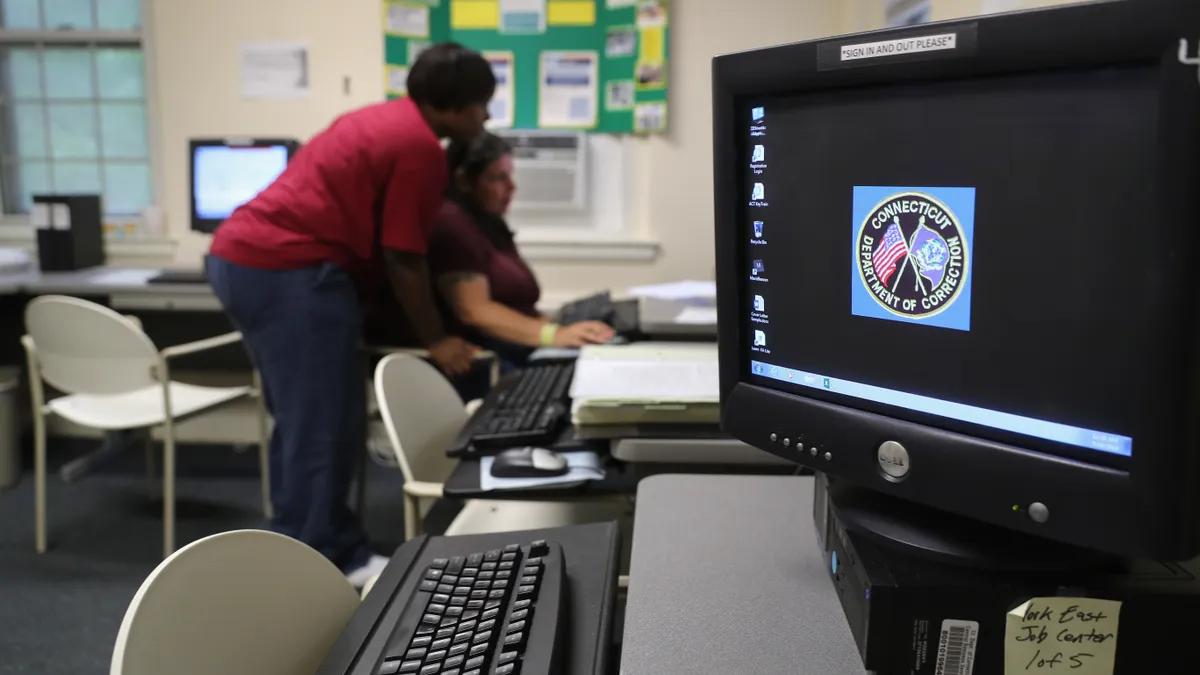The gender gap at the top of corporate America is real; women make up 6.6% of Fortune 500 CEOs, and that's the highest that number has ever been. Despite gaining ground in higher education, women's "underrepresentation at senior ranks remains a stubborn reality," according to Ripa Rashid, managing director of Culture@Work, a division of Working Mother Media.
Though many efforts will be needed to chip away at this "stubborn reality," one solution stands out: woman-to-woman mentorship. "I'm a big believer in mentorship for women by women, and female mentorship in the workplace is as important as ever," Amy Roy, chief people officer at Namely, told HR Dive in an email.
When women make it to the top of their organizations, the path upward may be easier and more attainable for their mentees and peers. "I've been fortunate to have had more than one mentor in my career who has provided insight that I might not have considered myself. I've also had the opportunity to mentor a number of women, early in their careers, and have learned that an outside perspective often provides an opportunity for reflection," Roy said. "Women are often trying to balance many things in their personal and professional lives. Taking the time to focus on a few key items can really make all the difference."
These connections, while important, don't always occur organically. HR professionals involved in learning and development (L&D) may be able to connect women who desire to grow professionally with women who are a little more advanced along similar career paths. They may see more success in pairing these women when they understand how the mentee-mentor relationship unfolds.
Play the mentorship matchmaker
Throughout the course of her career, Roy has seen the L&D and talent management teams act as strong conduits of mentorship, she said. "Specifically, I've seen L&D teams create emerging or developing leadership programs with classroom training where a mentee/mentor relationship is an additional layer," she said. "This provides an opportunity for a new leader to make a connection with someone outside of their immediate network and learn another part of the business."
Leaders within L&D can also help shape up mentorship. L&D can help put guidelines around the amount of time expected, how the mentee can prepare for their meetings and how the mentor can help without overstepping boundaries, for example.
Rashid suggested in an email to HR Dive that L&D plays two roles in connecting mentors and mentees. First, it can create structured programs in which mentors and mentees are assigned to each other or small groups. Second, it can support the cultivation of the mentor-mentee relationship. Resource guides and tool kits, events focused on speakers, and facilitated group sessions on professional development are some examples of the types of support L&D can provide.
Vivian Chen, founder and CEO of Rise, a flexible work platform, said L&D leaders should ensure mentors are true role models. It can be discouraging to a mentee to be paired with a mentor who stays in the office past 9 p.m. every day and never takes a vacation. "Ensure that mentors are those who are champions of work-life balance, flexibility, working from home, and other policies that encourage long-term personal and professional success," Chen said in an email to HR Dive.
Mentor seekers should start small
Mentorship matchmakers may want to keep in mind that the initiation of a mentorship can be intimidating for mentees. "For many women, finding a mentor can be daunting, not only is it scary to ask someone to be a mentor, but it can be a challenge to even know where to look," Chen said. She recommended women looking for a mentor seek out communities that are supporting and empowering women.
Roy suggested women start the mentorship search within their current surroundings. "The network you've undoubtedly cultivated over time is an amazing place to find other women, or like minded individuals, who can help you achieve your goals," she said.
She added that women ought to look within the workplace or a broader network of old colleagues, classmates or friends to understand who inspires them to work harder. "Then, don't be shy — work to establish a relationship that will be beneficial for years to come. If you feel uncomfortable reaching out to ask, think of someone in your circle who can make an introduction — that can help break the ice," she said. "I've often sent a quick email asking a colleague if they'd be willing to mentor ... and always have had a great response rate."
Mentee seekers can take a look back
Women often seek to mentor and develop more junior women as a means of "paying it forward," Rashid said. "Mentees can be found within one's reporting line, through an employee resource group, or even outside the workplace through a community service or volunteering organization."
Roy suggested women who are established in their career and looking to give back start with their surroundings — the workplace or a broader professional network — and look for others who share a similar trajectory they once did. In fact, L&D may want to offer help in their search for mentees.
But mentorships, no matter how they begin, take time to develop, Roy added. "Being a mentor is about helping and supporting others; on their schedules and timelines," she said. "However, you also need to consider your own bandwidth. What amount of time can you dedicate to the process and what areas are you able to help in? Once you've established your commitment, be open, supportive and ready to help when they need it the most."



















